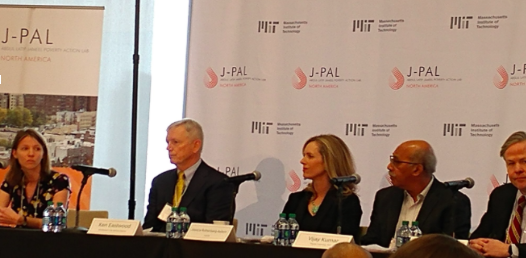Research and Innovation: Ed-Tech, Personalized Learning, & the Digital Divide @ J-PAL North America
Research and Innovation: Ed-Tech, Personalized Learning, & the Digital Divide
March 31st Conference at J-PAL North America
By Julie Guerette
On March 31, 2017, the J-PAL North America Conference brought together leaders from EdTech companies, higher education, public school systems, non-profits, and the White House. However, all shared the goal of answering this question: How can we make education, technology tools, and personalized learning available and accessible to all students around the world?
The conference kicked off with opening remarks by Quentin Palfrey, Executive Director of J-PAL North America. In the digital age, Palfrey believes, the “explosion of innovation has the power to supercharge pedagogical strategies.”
Although the recent innovations brought by technology and the digital age has great potential to bring new strategies, Palfrey’s former White House colleague Kumar Garg explained why pedagogy has not caught up yet. Garg, who led the Obama administration’s efforts to bolster STEM education, said the bottom line is that “we are just investing too little on education research.” Less than one percent of the national education budget goes to R&D, Garg explained, and this must change if we hope to discover new ways for students to learn.
Next came a panel discussion on personalized learning and the power of rigorous research. The discussion focused on the importance of keeping track of what methods and technologies are working in schools and which ones are not, and using that data to improve personalized learning approaches. Vijay Kumar, one of the panelists and Associate Dean of Digital Learning here at MIT, summed up how to best approach personalized learning: “learners come with different motivations, preparations, and aspirations. Personalization should meet them where they are.”
Keynote speaker Karen Cator, President and CEO of Digital Promise and former Director of the U.S. Office of Educational Technology, gave a compelling speech on the power of education and the need for equity in the American system. With the opportunity to have an education, Cator said, people have a way out of poverty. “Technology is not a silver bullet, but education is: it brings social justice, economic development, and more.”
The second panel discussion focused on improving access to education in the 21st century. Huge disparities in access to the internet, Rob Fairlie of UC Santa Cruz said, by race, income, and parental education are among the first barriers to learning that students face. “Technology enables access to information, and information is a poverty issue,” Emary Aronson from Robin Hood, a foundation that donates over $130 million to fight poverty each year, contributed.
Aneesh Chopra, first U.S. Chief Technology Officer appointed by President Obama, spoke both about his experiences serving in the White House and how data and evidence can transform education. A native of India, Chopra spoke about a project he initiated where everyone in an Indian town outside of New Delhi was given free broadband as an experiment to see how it affected their lives. When he went back to visit months later, Chopra saw that it had helped a student access courses online and a farmer obtain an official loan, saving him a lot of money. “Technology can allow us to leapfrog traditional intermediate steps in economic and educational development.”
R. David Edelman, another White House alum, now leads MIT’s new Project on Technology, the Economy, & National Security (TENS) after spending 10 years working in government technology policy. Perhaps the comment that stuck with me the most throughout the conference was when he asked “If we expect wifi in our coffee shops, shouldn’t we demand it in every one one of our classrooms?”
The internet is how we learn in the digital age; it’s how we connect to the world. Although there have been significant improvements in access to high-speed broadband in schools, some students are without it at home, severely limiting their ability to keep up with homework. The question I was left with at the conference, and I leave you with after reading this, is what ways can we ensure that all learners have the tools to learn? Technology should be a powerful mechanism that enables equity in education and pedagogy. How can we make sure it is used to bridge, not expand, the digital divide?


Comments are closed.